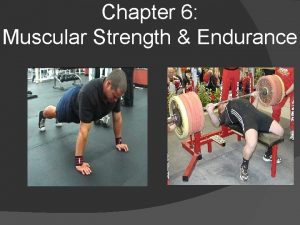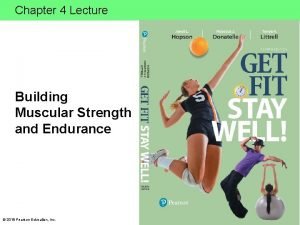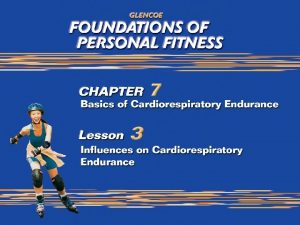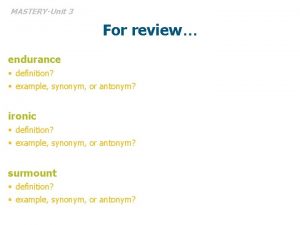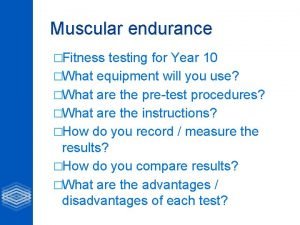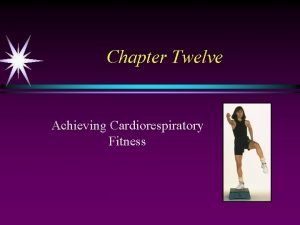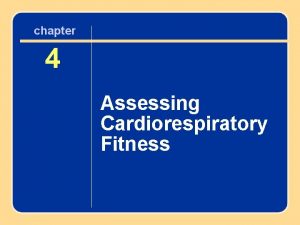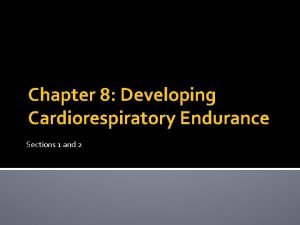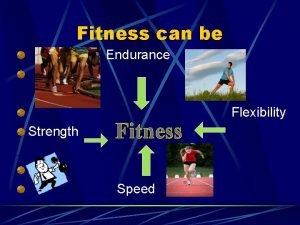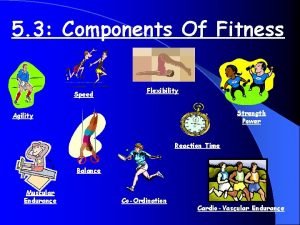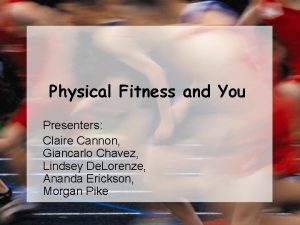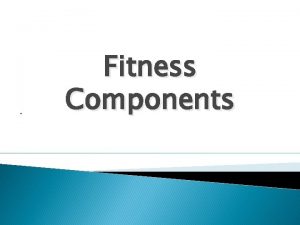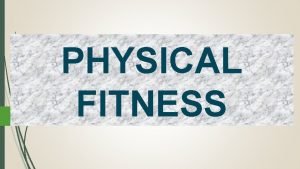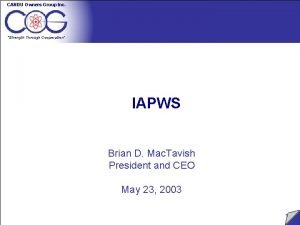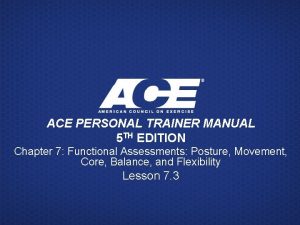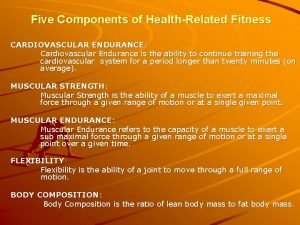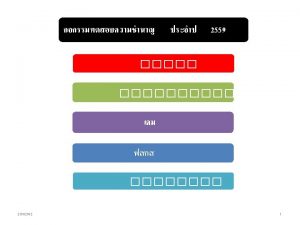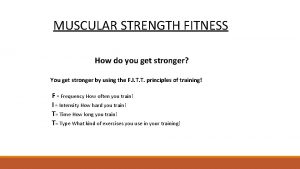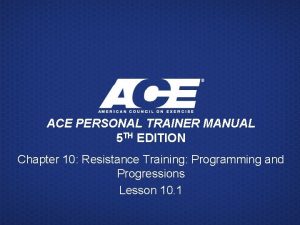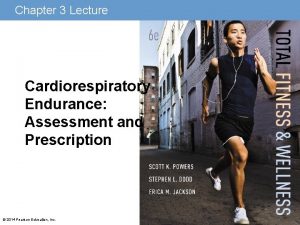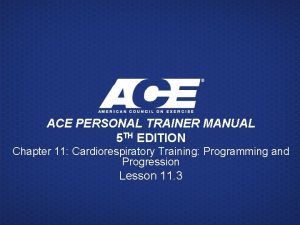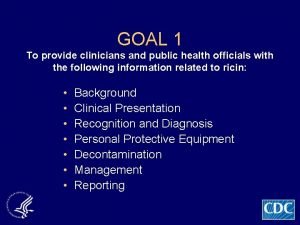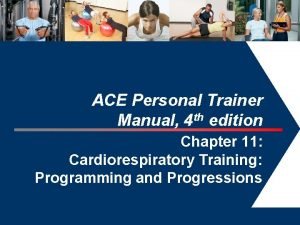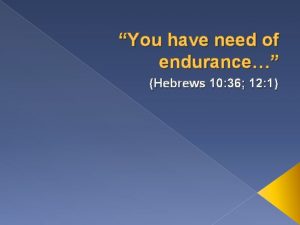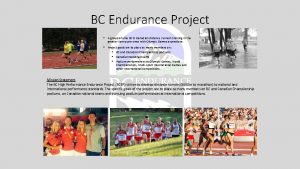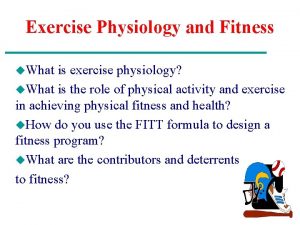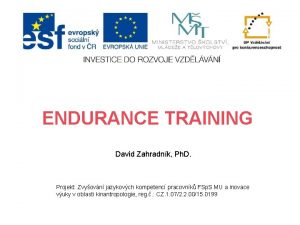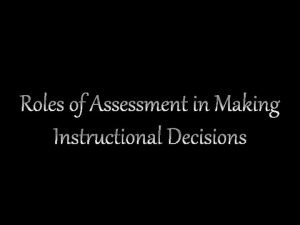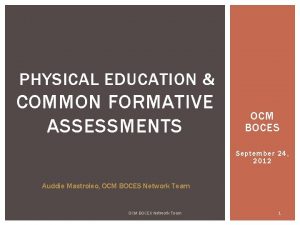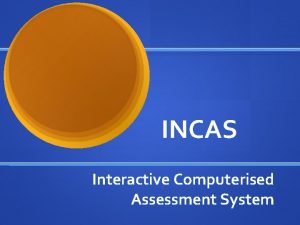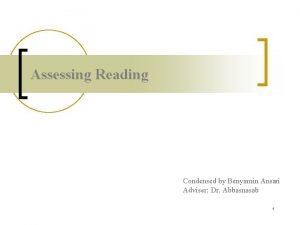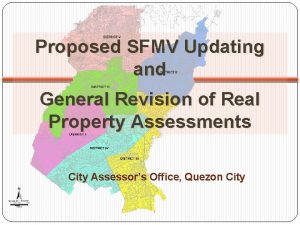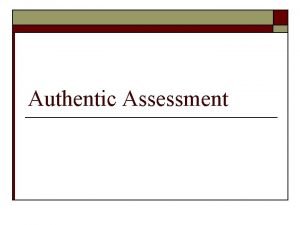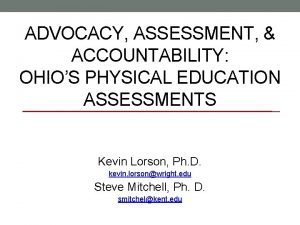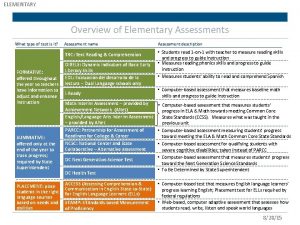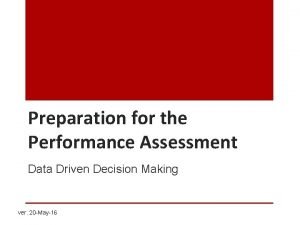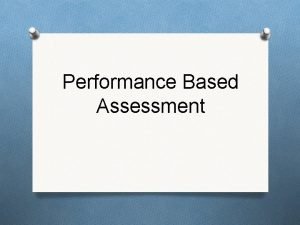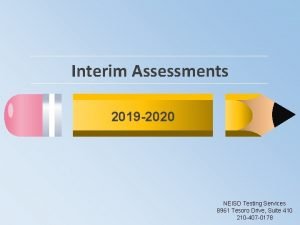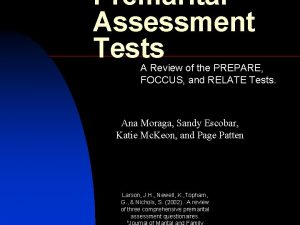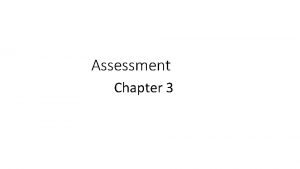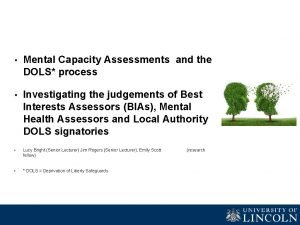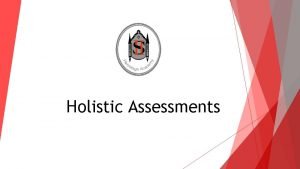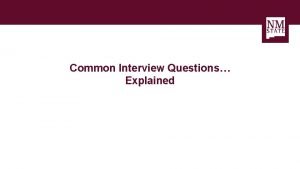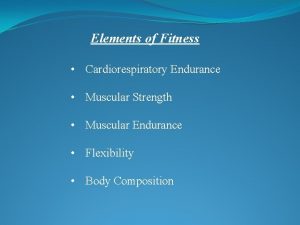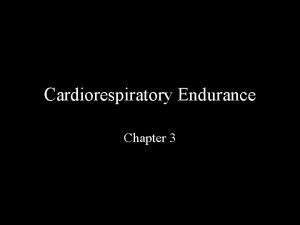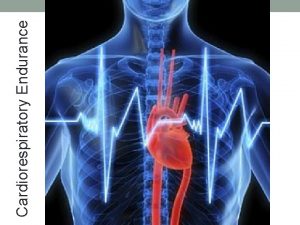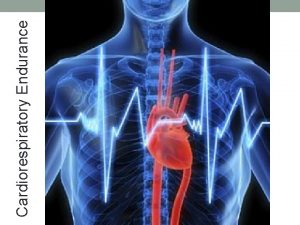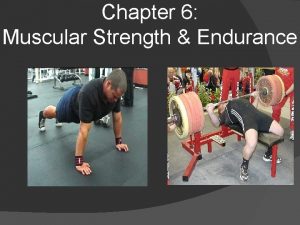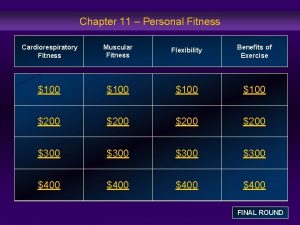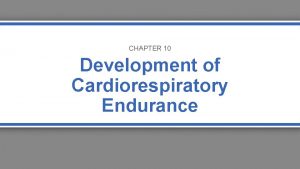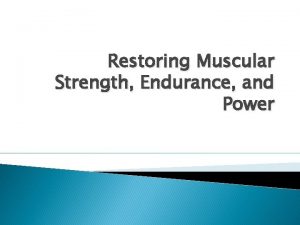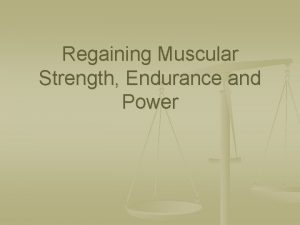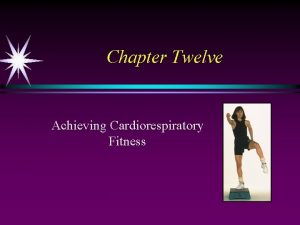Fitness Assessments Cardiorespiratory Fitness Muscular Strength Muscular Endurance
















































































































- Slides: 112

Fitness Assessments Cardiorespiratory Fitness Muscular Strength Muscular Endurance Flexibility

Define Cardiorespiratory fitness (CRF): • The ability to perform large muscle, dynamic, moderate- to high intensity exercise for prolonged periods of time and reflects the functional capabilities of the heart, blood vessels, lungs and relevant muscles.

What is the measurement of CRF used for? • Exercise prescription and programming • Progress in, and motivation of, an individual in an exercise program – provides feedback and motivation to keep a client interested in exercise • Prediction of medical conditions such as coronary artery disease (further identity or diagnose health problems)

How is the true measurement of CRF completed? • Involves maximal exertion as a result of graded exercise testing along with the collection of expired gasses during the exercise test.

Why is the true measurement of CRF not always done? • Measurement of expired gases is not always feasible • Procedure is likely beyond the scope of practice for many personal trainers

What medication could alter the results of a CRF assessment? • Beta-blockers

Field Tests • A field test generally requires the client to perform a task in a non-laboratory or field setting, such as running 1. 5 miles at near maximal exertion. • Field tests are relatively easy and inexpensive to administer and thus are ideal for testing large groups of clients.

Field Tests • Field tests, are considered to be submaximal, and may be inappropriate for safety reasons for sedentary individuals at moderate to high risk for cardiovascular or musculoskeletal complications.

What field tests are used to predict aerobic capacity? • 1. 5 mile run test • 1 mile walking test

1. 5 mile Run and 1 Mile Walking Test Guidelines • In the 1. 5 mile run test, the client can walk, run or use a combination of both to complete the test. • In the pure walking test, clients are strictly limited to walking (always having one foot on the ground at any given time) the entire test.

Who is the 1. 5 mile run test contraindicated for? • Beginners • Those with known heart disease or risk factors for heart disease

1. 5 mile run test guidelines • Clients should be able to jog for 15 minutes continuously to complete the 1. 5 mile run test to obtain a reasonable prediction of their aerobic capacity. • Clients need to be informed of the purpose of the test and the need to pace themselves over the 1. 5 miles distance.

1. 5 mile run test guidelines • Effective pacing and the client’s motivation are key variables in the outcome of the test. • Have clients start the test and start a stopwatch to coincide with the start. • Give your clients feedback on time throughout the assessment to help them with pacing.

1. 5 mile run test VO 2 Max Calculation • VO 2 max (m. L*KG*min) = 3. 5+483/ time

1. 5 mile run test VO 2 Max Calculation • Time is included in the equation. • You must convert seconds into a decimal. • To do this, divide the seconds by 60. • For example is a client’s time was 12 minutes and 51 seconds you divide 51/60 to get. 85.

1. 5 mile run test VO 2 Max Calculation • Convert following times into a whole number with a decimal Time 16: 24 17: 45 14: 21 Decimal

1. 5 mile run test VO 2 Max Calculation • Convert following times into a whole number with a decimal Time Decimal 16: 24 16. 40 17: 45 17. 75 14: 21 14. 35

1. 5 mile run test VO 2 Max Calculation • Example: Male client completed the 1. 5 mile run test in 16: 42 and is 43 years old. Calculate and classify VO 2 max. • VO 2 max (m. L*KG*min) = 3. 5+483/ time • Convert 42 seconds into a decimal. 42/60 =. 70 • VO 2 max (m. L*KG*min) = 3. 5+483/ 16. 70 • VO 2 max (m. L*KG*min) = 3. 5+28. 92 • VO 2 max (m. L*KG*min) = 32. 42 • Look on chart for classification: Below Average

1. 5 mile run test VO 2 Max Calculation • Calculate and classify VO 2 Max for: • Male, 1. 5 mile time: 13: 22, age 35

1. 5 mile run test VO 2 Max Calculation • Calculate and classify VO 2 Max for: • Female, 1. 5 mile time: 15: 43, age 29

1. 5 mile run test VO 2 Max Calculation • Calculate and classify VO 2 Max for: • Male, 1. 5 mile time: 16: 02, age 21

1. 5 mile run test VO 2 Max Calculation • Calculate and classify VO 2 Max for: • Female, 1. 5 mile time: 11: 34, age 19

Who is the 1 mile walk test useful for? • Those who are unable to run because of low fitness and/or injury.

What are the requirements for the 1 mile walk test? • Keep exercise heart rate above 120 bpm. • Have clients walk 1 mile as fast as possible without running

1 Mile Walk Test Guidelines • Immediately at the end of the 1 -mile walk, the personal trainer counts the recovery heart rate for 15 seconds and multiplies by 4 to determine a 1 minute recovery. • It has been shown that using a heart rate monitor may give the client more accurate results than manual palpation of heart rate.

1 Mile Walk Test Calculations • There are 2 equations for the 1 mile walk test. • The equation used with individuals younger than 30 is: • 132. 853 - (. 0769 X weight in kilograms) – (. 3877 X age) + (6. 315, for men only) – (3. 2649 X time) – (. 1565 X HR)

1 Mile Walk Test Calculations • The equation used with individuals age 30 -69: • 132. 853 - (. 1692 X weight in kilograms) – (. 3877 X age) + (6. 315, for men only) – (3. 2649 X time) – (. 1565 X HR) • • In both equations 6. 315 is only added in for males. For a female you skip that step.

1 Mile Walk Test Calculations • To perform the calculation your client’s weight must be converted to kilograms. To do this, divide the weight by 2. 2. • Example: Client weighs 150 pounds to convert to kilograms divide by 2. 2 • 150/2. 2 = 68. 18 kg

1 Mile Walk Test Calculations • Example: Female client weighs 216 pounds and completed the 1 mile walk test in 14: 21, client is 36 years old, heart rate was 144 bpm. Calculate VO 2 max • Use the equation for individuals age 30— 69 • 132. 853 - (. 1692 X weight in kilograms) – (. 3877 X age) + (6. 315, for men only) – (3. 2649 X time) – (. 1565 X HR) • The 6. 315 will be omitted because this is a female • Step 1: Convert weight to kilograms 216/2. 2 = 98. 18 kg • Step 2: Convert seconds to a decimal 21/60 =. 35 • Step 3: plug information into equation • 132. 853 – (. 1692 x 98. 18) – (. 3877 x 36) – (3. 2649 x 14. 35) – (. 1565 x 144) • 132. 853 – 16. 61 – 13. 96 – 46. 85 – 22. 54 • VO 2 Max = 32. 893, classified as below average/ average

1 Mile Walk Test Calculations • Example: Male client weighs 197 pounds and completed the 1 mile walk test in 13: 48, client is 28 years old, heart rate was 158 bpm. Calculate VO 2 max • Use the equation for individuals under age 30 • 132. 853 - (. 0769 X weight in kilograms) – (. 3877 X age) + (6. 315, for men only) – (3. 2649 X time) – (. 1565 X HR) • The 6. 315 will be included because this is a male • Step 1: Convert weight to kilograms • 197/2. 2 = 89. 55 kg • Step 2: Convert seconds to a decimal • 48/60 =. 80 • Step 3: plug information into equation • 132. 853 – (. 0769 x 89. 55) – (. 3877 x 28) +6. 315 – (3. 2649 x 13. 80) – (. 1565 x 158) • 132. 853 – 6. 88 – 10. 86 + 6. 315 – 45. 06 – 24. 73 • VO 2 Max = 51. 64, classified as good

1 Mile Walk Test Calculations • Calculate and classify VO 2 Max for: • Male, 1 mile time: 15: 13, age 25, weight 190 pounds, Heart Rate: 164 bpm

1 Mile Walk Test Calculations • Calculate and classify VO 2 Max for: • Female, 1 mile time: 14: 26, age 32, weight 143 pounds, Heart Rate: 156 bpm

1 Mile Walk Test Calculations • Calculate and classify VO 2 Max for: • Male, 1 mile time: 13: 17, age 41, weight 175 pounds, Heart Rate: 148 bpm

1 Mile Walk Test Calculations • Calculate and classify VO 2 Max for: • Female, 1 mile time: 16: 44, age 27, weight 164 pounds, Heart Rate: 168 bpm

What is the Queens College step test based on? • Recovery heart rate; the lower the recovery heart rate the more fit the individual

What equipment is needed to administer the queen’s college step test? • Watch • Metronome • Step at 16. 25 inches

If using a step bench, how many risers are put under the platform? • 6 risers per side

Who is the step test be contraindicated for? • Clients with balance issues • Clients that have difficulty stepping

Queens College Step Test Guidelines Step Height Duration Men’s Cadence Women’s Cadence 16. 25 inches 3 minutes 24 steps per minute 22 steps per minute Metronome set to 96 bpm Metronome set to 88 bpm

Queens College Step Test Guidelines • After 3 minutes of stepping are completed, the client stops and has his or her pulse taken while standing within the first 5 seconds. • A 15 second pulse count is then taken and multiplied by 4 to determine HR in BPM. • The recovery HR should occur between 5 and 20 seconds of immediate recovery from the end of the step test.

Queens College Step Test Calculations • Males: • VO 2 Max = 111. 33 – (. 42 x HR) • Females: • VO 2 Max = 65. 81 – (0. 1847 X HR)

Queens College Step Test Calculations • • • Calculate and classify VO 2 Max for: Male, 39 years old, recovery HR 96 bpm VO 2 Max = 111. 33 – (. 42 x 96) VO 2 Max = 111. 33 -40. 32 VO 2 Max = 71. 01, Excellent

Queens College Step Test Calculations • Calculate and classify VO 2 Max for: • Female, 24 years old, recovery HR 104 bpm • VO 2 Max = 65. 81 - (. 1847 x 104) • VO 2 Max = 65. 81 - 19. 21 • VO 2 Max = 46. 6, Above Average

Queens College Step Test Calculations • Calculate and classify VO 2 Max for: • Male, 33 years old, recovery HR 134 bpm

Queens College Step Test Calculations • Calculate and classify VO 2 Max for: • Female, 57 years old, recovery HR 142 bpm

Queens College Step Test Calculations • Calculate and classify VO 2 Max for: • Male, 48 years old, recovery HR 165 bpm

Queens College Step Test Calculations • Calculate and classify VO 2 Max for: • Female, 23 years old, recovery HR 155 bpm

What are the two forms of cycle ergometer tests? • Astrand-Rhyming • YMCA Submaximal Bike Test

What is muscular strength? • One-time maximal force that may be exerted and is localized to a joint or muscle group

What does one repetition maximum 1 RM stand for? • One-time maximum amount of weight lifted

What is a good way of expressing muscular strength? • As a ratio of total body weight, determined by dividing weight lifted by body weight • Weight Ratio = weight pushed in pounds body weight in pounds

Calculating Weight Ratio • Example: Male client, age 32 weighs 198 pounds and bench pressed 215 pounds 1 time. Calculate and classify the muscular strength ratio. • • 215/198 = 1. 09, Good/Excellent

Calculating Weight Ratio • Calculate and classify muscular strength ratio: • Male, Age – 43, Weight 167 pounds, 1 RM = 155 pounds

Calculating Weight Ratio • Calculate and classify muscular strength ratio: • Female, Age – 38, Weight 124 pounds, 1 RM = 130 pounds

Calculating Weight Ratio • Calculate and classify muscular strength ratio: • Male, Age – 22, Weight 188 pounds, 1 RM = 225 pounds

Calculating Weight Ratio • Calculate and classify muscular strength ratio: • Female, Age – 53, Weight 85 pounds, 1 RM = 85 pounds

The 1 RM bench press measures the strength of what three muscle groups? • Triceps • Pectoralis Major • Rear Deltoid

Who should not complete a 1 RM test? • Elderly • Those with significant orthopedic limitations • Pregnant Women

1 RM testing protocol • Allow the client to become comfortable with the bench press and its operation by practicing a light warm-up of 5 to 10 repetitions at 40 to 60% perceived maximum

1 RM testing protocol • For the test, the client is to keep his or her back on the bench, both feet on the floor, and the hands should be shoulder width apart with palms up on the bar. • It is necessary for the personal trainer to ensure that the client is using a closed grip with the thumbs on one side of the bar and the other fingers encircling the bar. • A spotter must be present for all lifts. The spotter hands the bar to the subject. • The client starts the lift with the bar in the up position and arms fully extended. • The bar is lowered to the chest and then pushed back up until the arms are locked. • Be mindful of breathing and avoid the Valsalva maneuver.

1 RM testing protocol • Following a 1 -minute rest with light stretching, the subject does three to five repetitions at 60% to 80% of perceived maximum.

1 RM testing protocol • The client should be close to the perceived maximum. • Add a small amount of weight and a 1 RM lift is attempted. • If the lift is successful, a rest period of 3 to 5 minutes is provided. • The goal is to find the 1 RM in 3 to 5 maximal efforts. • The process continues until a failed attempt occurs. • The greatest amount lifted is considered 1 RM.

1 RM testing protocol • The client should be close to the perceived maximum. • Add a small amount of weight and a 1 RM lift is attempted. • If the lift is successful, a rest period of 3 to 5 minutes is provided. • The goal is to find the 1 RM in 3 to 5 maximal efforts. • The process continues until a failed attempt occurs. • The greatest amount lifted is considered 1 RM.

Define Muscular Endurance • The ability to apply a force repeatedly over time.

Test used to measure Muscular Endurance • Partial Curl Up • Push Up

Equipment Used for Push Up Test • Mat • Yoga Block

Who Should Not Perform the Push Up Test • Individuals with wrist or shoulder problems

Push Up Test Procedures • The push up test is administered with male subjects starting in the standard “down” position (hands pointing forward and under the shoulder, back straight, head up, using the toes as the pivotal point) • Female subjects in the modified “Knee push up” position (legs together lower leg in contact with mat with ankles plantarflexed, back straight, hands shoulder width apart, head up, using the knees as the pivotal point).

Push Up Test Procedures • The subject must raise the body by straightening the elbows and return to the “down” position, until the chest touches the yoga block. The stomach should not touch the mat.

Push Up Test Procedures • For both men and women the subject’s back must be straight at all times and the subject must push up to a straight arm position. • The maximal number of pushups performed consecutively without rest is counted as the score. • The test is stopped when the client strains forcibly or Is unable to maintain the appropriate technique within two repetitions

Push Up Test Classifications • Classify the following push up test results Male Female Age: 25 Pushups: 45 Age: 28 Pushups: 37 Classification: Age: 43 Pushups: 21 Age: 63 Pushups: 8 Classification: Age: 36 Pushups: 5 Age: 48 Pushups: 9 Classification:

Partial Curl Up Test - Equipment • Mat with tape 12 cm apart for clients <45 and 8 cm apart for clients > 45 • Metronome set at 40 beats per minute

Who Should Not Perform the Partial Curl Up Test? • Pregnant women • People with low back pain • Individuals with recent abdominal or low back surgery

Who Should Not Perform the Partial Curl Up Test? • Pregnant women • People with low back pain • Individuals with recent abdominal or low back surgery

Partial Curl Up Test Procedures • Two strips of masking tape are to be placed on a mat on the floor at a distance of 12 cm apart (for clients < 45 years) or 8 cm apart (for clients > 45 years)

Partial Curl Up Test Procedures • Subjects are to lie in a supine position across the tape, knees bent at 90 degrees with feet on the floor and arms extended to their sides, so that their fingertips touch the nearest strip. This is the bottom position. • To reach the top position, subjects flex their spines to 30 degrees, reaching their hands forward until their fingers touch the second strip of tape.

Partial Curl Up Test Procedures • A metronome is set at 40 beats per minute. At the first beep the subject begins the curl up, reaching the top position at the second beep, returning to the starting position at the third, top at the fourth etc.

Partial Curl Up Test Procedures • Repetitions are counted each time the subject reaches the bottom position. The test is concluded either when the subject reaches 75 curl ups or when the cadence is broke. • Every subject will be allowed several practice repetitions prior to the start of the test.

Partial Curl Up Test Classifications • Classify the following partial curl up test results Male Female Age: 25 Curl-ups: 60 Age: 28 Curl-ups: 52 Classification: Age: 43 Curl-ups: 47 Age: 63 Curl-ups: 15 Classification: Age: 36 Curl-ups: 23 Age: 48 Curl-ups: 26 Classification:

What is the name of the test used to measure flexibility? • Sit and Reach Test

The flexibility of what muscles groups are measured with the Sit and Reach Test? • Hamstrings • Lower Back • Hips

Why is flexibility measured? • The practical significance of using the sit and reach test to measure flexibility is the significant number of people who complain of low back pain. • It is likely that this pain is caused by decreased flexibility, primarily of the hamstrings.

Sit and Reach Procedures • Pretest: Participant should perform a short warm up (5 -7 minutes) prior to this test and include some stretches for the targeted muscle groups (i. e. modified hurdlers stretch). • It is also recommended that the participant refrain from fast jerky movements, which may increase the possibility of an injury. • The participant’s shoes should be removed for the assessment.

Sit and Reach Procedures • The client sits without shoes and the soles of the feet flat against the sit and reach box at the 26 cm mark. Inner edges of the soles are placed within 2 cm of the measuring scale.

Sit and Reach Procedures • The participant should slowly reach forward (no bouncing) with both hands as far as possible to the point of mild discomfort), holding this position approximately 2 seconds. • Be sure that the participant keeps the hands parallel and does not lead with one hand. • Fingertips can be overlapped and should be in contact with the measuring portion of the sit and reach box. • To assist with the best attempt, the participant should exhale and drop the head between the arms when reaching.

Sit and Reach Procedures • Testers should ensure that the knees of the participant stay extended; however the participant’s knees should not be pressed down. • The participant should breathe normally during the test and should not hold his or her breath anytime.

Sit and Reach Procedures • Testers should ensure that the knees of the participant stay extended; however the participant’s knees should not be pressed down. • The participant should breathe normally during the test and should not hold his or her breath anytime.

Sit and Reach Procedures • The score is the more distant point reached with the fingertips. The best of two trials should be recorded.

Sit and Reach Test Classifications • Classify the following sit and reach test results Male Female Age: 25 Trial 1: 10 inches Trial 2: 10 inches Age: 18 Trial 1: 22. 5 inches Trial 2: 24. 25 inches Farthest Measurement: Classification: Age: 72 Trial 1: 14 inches Trial 2: 15 inches Age: 40 Trial 1: 17. 5 inches Trial 2: 19 inches Farthest Measurement: Classification: Age: 53 Trial 1: 10 inches Trial 2: 11 inches Age: 32 Trial 1: 18 inches Trial 2: 19 inches Farthest Measurement: Classification:

Fitness Assessment Interpretation • If a client scores poorly or has failed to demonstrate progress in certain areas, then answers should be sought as to why the changes were not evident and how the exercise program should be adjusted to produce the desired changes in the future. • It is important to realize that not all individuals are going to adapt to programming suggestions in the same way. • Each round of health-related physical fitness assessments calls for a reexamination of the

Fitness Assessments - Answer Key Cardiorespiratory Fitness Muscular Strength Muscular Endurance Flexibility

1. 5 mile run test VO 2 Max Calculation • Calculate and classify VO 2 Max for: • Male, 1. 5 mile time: 13: 22, age 35 • • • VO 2 max (m. L*KG*min) = 3. 5+483/ time VO 2 max (m. L*KG*min) = 3. 5+483/ 13: 22 22/60=. 37 VO 2 max (m. L*KG*min) = 3. 5+483/ 13. 37 VO 2 max (m. L*KG*min) = 3. 5+36. 13 VO 2 max (m. L*KG*min) = 35. 13 m. L*KG*min • Below average

1. 5 mile run test VO 2 Max Calculation • Calculate and classify VO 2 Max for: • Female, 1. 5 mile time: 15: 43, age 29 • • • VO 2 max (m. L*KG*min) = 3. 5+483/ time VO 2 max (m. L*KG*min) = 3. 5+483/ 15: 43 43/60=. 72 VO 2 max (m. L*KG*min) = 3. 5+483/ 15. 72 VO 2 max (m. L*KG*min) = 3. 5+30. 73 VO 2 max (m. L*KG*min) = 34. 23 m. L*KG*min • Below average

1. 5 mile run test VO 2 Max Calculation • Calculate and classify VO 2 Max for: • Male, 1. 5 mile time: 16: 02, age 21 • • • VO 2 max (m. L*KG*min) = 3. 5+483/ time VO 2 max (m. L*KG*min) = 3. 5+483/ 16: 02 2/60=. 03 VO 2 max (m. L*KG*min) = 3. 5+483/ 16. 03 VO 2 max (m. L*KG*min) = 3. 5+30. 13 VO 2 max (m. L*KG*min) = 33. 63 m. L*KG*min • Poor

1. 5 mile run test VO 2 Max Calculation • Calculate and classify VO 2 Max for: • Female, 1. 5 mile time: 11: 34, age 19 • • • VO 2 max (m. L*KG*min) = 3. 5+483/ time VO 2 max (m. L*KG*min) = 3. 5+483/ 11: 34 34/60=. 57 VO 2 max (m. L*KG*min) = 3. 5+483/ 11. 57 VO 2 max (m. L*KG*min) = 3. 5+41. 75 VO 2 max (m. L*KG*min) = 45. 25 m. L*KG*min • Above average

1 Mile Walk Test Calculations • Calculate and classify VO 2 Max for: • Male, 1 mile time: 15: 13, age 25, weight 190 pounds, Heart Rate: 164 bpm • • Convert weight to Kg 190/2. 2 = 86. 36 Convert time into a decimal 13/60 =. 22 (15. 22) • 132. 853 - (0. 0769 X 86. 36) – (0. 3877 X 25) + (6. 315) – (3. 2649 X 15. 22) – (0. 1565 X 164) • 132. 853 – (6. 64)- (9. 69) + (6. 315) – (49. 69) – (25. 66) • 47. 218 m. L*KG*min • Average

1 Mile Walk Test Calculations • Calculate and classify VO 2 Max for: • Female, 1 mile time: 14: 26, age 32, weight 143 pounds, Heart Rate: 156 bpm • • Convert weight to Kg 143/2. 2 = 65 Convert time into a decimal 26/60 =. 43 (14. 43) • 132. 853 - (0. 1692 X 65) – (0. 3877 X 32) – (3. 2649 X 14. 43) – (0. 1565 X 156) • 132. 853 – (10. 998)- (12. 41)– (47. 11) – (24. 41) • 37. 943 m. L*KG*min • Average

1 Mile Walk Test Calculations • Calculate and classify VO 2 Max for: • Male, 1 mile time: 13: 17, age 41, weight 175 pounds, Heart Rate: 148 bpm • • Convert weight to Kg 175/2. 2 = 79. 55 Convert time into a decimal 17/60 =. 28 (13. 28) • 132. 853 - (0. 1692 X 79. 55) – (0. 3877 X 41) + (6. 315) – (3. 2649 X 13. 28) – (0. 1565 X 148) • 132. 853 – (13. 46)- (15. 90) + (6. 315) – (43. 36) – (23. 162) • 43. 286 m. L*KG*min • Above Average

1 Mile Walk Test Calculations • Calculate and classify VO 2 Max for: • Female, 1 mile time: 16: 44, age 27, weight 164 pounds, Heart Rate: 168 bpm • • Convert weight to Kg 168/2. 2 = 76. 36 Convert time into a decimal 44/60 =. 73 (16. 73) • 132. 853 - (0. 0769 X 76. 36) – (0. 3877 X 27) – (3. 2649 X 16. 73) – (0. 1565 X 168) • 132. 853 – (12. 92)- (10. 47)– (54. 62) – (26. 29) • 28. 553 m. L*KG*min • Poor

Queens College Step Test Calculations • Calculate and classify VO 2 Max for: • Male, 33 years old, recovery HR 134 bpm • • VO 2 max (m. L*KG*min) = 111. 33 – (0. 42 X HR) VO 2 max (m. L*KG*min) = 111. 33 – (0. 42 X 134) VO 2 max (m. L*KG*min) = 111. 33 – (45. 83) VO 2 max (m. L*KG*min) = 65. 5 • Excellent

Queens College Step Test Calculations • Calculate and classify VO 2 Max for: • Female, 57 years old, recovery HR 142 bpm • • VO 2 max (m. L*KG*min) = 65. 81 – (0. 1847 X HR) VO 2 max (m. L*KG*min) = 65. 81 – (0. 1847 X 142) VO 2 max (m. L*KG*min) = 65. 81 – (26. 23) VO 2 max (m. L*KG*min) = 39. 58 • Good/Excellent

Queens College Step Test Calculations • Calculate and classify VO 2 Max for: • Male, 48 years old, recovery HR 165 bpm • • VO 2 max (m. L*KG*min) = 111. 33 – (0. 42 X HR) VO 2 max (m. L*KG*min) = 111. 33 – (0. 42 X 165) VO 2 max (m. L*KG*min) = 111. 33 – (69. 3) VO 2 max (m. L*KG*min) = 42. 03 • Good

Queens College Step Test Calculations • Calculate and classify VO 2 Max for: • Female, 23 years old, recovery HR 155 bpm • • VO 2 max (m. L*KG*min) = 65. 81 – (0. 1847 X HR) VO 2 max (m. L*KG*min) = 65. 81 – (0. 1847 X 155) VO 2 max (m. L*KG*min) = 65. 81 – (28. 63) VO 2 max (m. L*KG*min) = 37. 18 • Below Average

Calculating Weight Ratio • Calculate and classify muscular strength ratio: • Male, Age – 43, Weight 167 pounds, 1 RM = 155 pounds • 155/167 = 0. 93 • Good

Calculating Weight Ratio • Calculate and classify muscular strength ratio: • Female, Age – 38, Weight 124 pounds, 1 RM = 130 pounds • 130/124 = 1. 05 • Superior

Calculating Weight Ratio • Calculate and classify muscular strength ratio: • Male, Age – 22, Weight 188 pounds, 1 RM = 225 pounds • 225/188 = 1. 19 • Good

Calculating Weight Ratio • Calculate and classify muscular strength ratio: • Female, Age – 53, Weight 85 pounds, 1 RM = 85 pounds • 85/153 = 0. 56 • Excellent

Calculating Weight Ratio • You completed a 1 RM test on 2 clients with the following results. Calculate their muscular strength ratio and use the tables to determine the classification of their result. • Answer for female client: • 95/142 =. 67, Good

Calculating Weight Ratio • You completed a 1 RM test on 2 clients with the following results. Calculate their muscular strength ratio and use the tables to determine the classification of their result. • Answer for male client: • 190/187 = 1. 12, Fair

Push Up Test Classifications • Classify the following push up test results Male Female Age: 25 Pushups: 45 Age: 28 Pushups: 37 Classification: Excellent Age: 43 Pushups: 21 Age: 63 Pushups: 8 Classification: Very Good Classification: Good Age: 36 Pushups: 5 Age: 48 Pushups: 9 Classification: Needs Improvement Classification: Fair

Partial Curl Up Test Classifications • Classify the following partial curl up test results Male Female Age: 25 Curl-ups: 60 Age: 28 Curl-ups: 52 Classification: Above Average Age: 43 Curl-ups: 47 Age: 63 Curl-ups: 15 Classification: Average Age: 36 Curl-ups: 23 Age: 48 Curl-ups: 26 Classification: Below Average Classification: Average

Sit and Reach Test Classifications • Classify the following sit and reach test results Male Female Age: 25 Trial 1: 10 inches Trial 2: 10 inches Age: 18 Trial 1: 22. 5 inches Trial 2: 24. 25 inches Farthest Measurement: 10 inches Classification: well below average Farthest Measurement: 24. 25 inches Classification: Well Above Average Age: 72 Trial 1: 14 inches Trial 2: 15 inches Age: 40 Trial 1: 17. 5 inches Trial 2: 19 inches Farthest Measurement: 15 inches Classification: Above average Farthest Measurement: 19 inches Classification: Above average Age: 53 Trial 1: 10 inches Trial 2: 11 inches Age: 32 Trial 1: 18 inches Trial 2: 19 inches Farthest Measurement: 11 inches Classification: Below average Farthest Measurement: 19 inches Classification: Average
 Plyometrics disadvantages
Plyometrics disadvantages Principles of weight training
Principles of weight training Venn diagram of muscular strength and endurance
Venn diagram of muscular strength and endurance Describe cardiorespiratory endurance
Describe cardiorespiratory endurance Example synonym
Example synonym Muscular endurance fitness test
Muscular endurance fitness test Chapter 12 achieving cardiorespiratory fitness
Chapter 12 achieving cardiorespiratory fitness Assessing cardiorespiratory fitness
Assessing cardiorespiratory fitness Developing cardiorespiratory fitness
Developing cardiorespiratory fitness Be endurance
Be endurance Difference between strength and endurance
Difference between strength and endurance Speed flexibility
Speed flexibility Muscular endurance workout
Muscular endurance workout Local muscular endurance definition
Local muscular endurance definition The ability to do strength work at an explosive pace.
The ability to do strength work at an explosive pace. Candu owners group
Candu owners group Mcgill's torso test battery flexor
Mcgill's torso test battery flexor Cardiovascular endurance health related fitness
Cardiovascular endurance health related fitness What is physical fitness test in mapeh
What is physical fitness test in mapeh Ratio strength to percentage strength
Ratio strength to percentage strength Steel bar
Steel bar Percentage strength w/w formula
Percentage strength w/w formula Half strength darrows
Half strength darrows How is muscular strength defined?
How is muscular strength defined? Muscular strength
Muscular strength Muscular strength
Muscular strength Paf 30
Paf 30 Benefits of cardiorespiratory training
Benefits of cardiorespiratory training Tissue in cardiovascular system
Tissue in cardiovascular system Ace ift model cardiorespiratory training
Ace ift model cardiorespiratory training Pulmonary toilet
Pulmonary toilet Ace ift model cardiorespiratory
Ace ift model cardiorespiratory Cardiorespiratory adalah
Cardiorespiratory adalah Benefits of skill related fitness
Benefits of skill related fitness Fitness mapeh
Fitness mapeh Hebrews 10:36 sermon
Hebrews 10:36 sermon Let us run with endurance
Let us run with endurance Bc endurance project
Bc endurance project Haydee endurance test
Haydee endurance test Perdurance theory
Perdurance theory Randfontein mogale endurance ride
Randfontein mogale endurance ride What is endurance?
What is endurance? Fitness u
Fitness u Haydee endurance test
Haydee endurance test Endurance limit
Endurance limit Special endurance 1
Special endurance 1 Resin cast potential transformer
Resin cast potential transformer Endurance trainig
Endurance trainig Formule brzycki
Formule brzycki Tinman endurance coaching
Tinman endurance coaching Endurance management group
Endurance management group Bank angle aircraft
Bank angle aircraft Regina high performance endurance
Regina high performance endurance Aimsweb plus benchmark assessments
Aimsweb plus benchmark assessments Sat suite of assessments
Sat suite of assessments Formative summative and diagnostic assessment
Formative summative and diagnostic assessment What does olivia mean
What does olivia mean Common formative assessment examples
Common formative assessment examples Rating yourself
Rating yourself Outmatch assessments
Outmatch assessments Osde assessments
Osde assessments Incas assessments
Incas assessments Beben benyamin
Beben benyamin Summative elpac scale score ranges
Summative elpac scale score ranges Assessments that favor one group over another are
Assessments that favor one group over another are التحصيلي
التحصيلي General revision of assessments and property classification
General revision of assessments and property classification Strategi penilaian pembelajaran
Strategi penilaian pembelajaran Writing analytical assessments in social work
Writing analytical assessments in social work Lausd interim assessments
Lausd interim assessments Authenticity in assessment meaning
Authenticity in assessment meaning Analytic rubrics for design a museum exhibit
Analytic rubrics for design a museum exhibit Irip
Irip Common core ela assessments
Common core ela assessments Next generation assessments examples
Next generation assessments examples Ricas accommodations
Ricas accommodations Florida assessment for instruction in reading
Florida assessment for instruction in reading Ohio physical education assessments
Ohio physical education assessments Cte technical skills assessments.azed.gov/student
Cte technical skills assessments.azed.gov/student Anet interim assessments
Anet interim assessments Performance assessment examples
Performance assessment examples Iowa staewide assessment of student progress
Iowa staewide assessment of student progress Vdoe algebra readiness
Vdoe algebra readiness Formal and informal assessment
Formal and informal assessment Www.fors-online.org.uk
Www.fors-online.org.uk Mlpp assessments
Mlpp assessments Strengths in reading
Strengths in reading Kentucky assessments science
Kentucky assessments science Characteristics of performance-based assessment
Characteristics of performance-based assessment Ddi assessments
Ddi assessments Fs assessments.org/apm
Fs assessments.org/apm Aware online testing neisd
Aware online testing neisd Creative arts grade 7 term 2 activities
Creative arts grade 7 term 2 activities Premarital tests or assessments
Premarital tests or assessments Rhode island comprehensive assessments system
Rhode island comprehensive assessments system Glba risk assessment requirements
Glba risk assessment requirements Informative assesment
Informative assesment Characteristics of psychological assessment
Characteristics of psychological assessment Datarich student assessments
Datarich student assessments 6 assessments for dols
6 assessments for dols Eccentric viewing techniques occupational therapy
Eccentric viewing techniques occupational therapy Holistic assessments
Holistic assessments Intermolecular forces are attractions between
Intermolecular forces are attractions between Assessing a new venture's financial strength and viability
Assessing a new venture's financial strength and viability Red fort
Red fort Lewis equation
Lewis equation Wish you strength
Wish you strength What is your greatest strength
What is your greatest strength Why do hurricanes lose strength over land
Why do hurricanes lose strength over land Adhesive strength increaser
Adhesive strength increaser What personality is blue
What personality is blue Laminame
Laminame Newton's law of universal gravitation
Newton's law of universal gravitation

